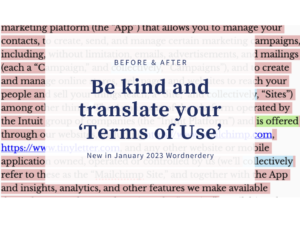 This may be a new year, but it’s the same old, same old when it comes to wordy, baffling language. And you’ll find lots of that in any company’s Terms of Use.
This may be a new year, but it’s the same old, same old when it comes to wordy, baffling language. And you’ll find lots of that in any company’s Terms of Use.
Terms of Use should be easy to read, don’t you think? And making them easy is just being kind. Some companies do appear kind, sending updates they suggest are making the terms easier to read. But are they?
The January issue of my newsletter, Wordnerdery, looks at the terms governing my relationship with Mailchimp, which sends the newsletter. More specifically, it looks at the definitions, presented in typical legal style: Full Term, duly capitalized (“Short Term,” in quotes and capitalized).
MailChimp starts off kindly enough with a caution: “Please read these Standard Terms of Use (“Terms”) carefully.” And the pinky-red colour highlighting the very-hard-to-read sentences that follow shows you need to read them carefully.
Where did they go wrong?
- Running the terms through the Hemingway app says Mailchimp wrote this section at a “post graduate” level, typical of dense academic papers. Only about 4.5% of adults can comfortably read at this level. “Poor,” the app says. “Aim for 14.”
- Of eight sentences, four are very hard to read.
- The definitions are summed up in sentences averaging 34 words each. An average of nine to 14 words in a sentence results in 90-99% understanding. Over 33 is about 30-39%.
One of the fastest ways to streamline sentences, according to writing coach Ann Wylie, is to use a period more often. Taking this tactic with the “before,” I started breaking up sentences on the Hemingway page. I could watch the complexity level magically drop to Grade 11 as I worked, with the encouragement “try for 9.”
I also simplified, removed repetition and took out lawyerspeak like “without limitation.” And I turned a complicated section about who Contacts are into a bulleted list and removed the “in other words.” If you need to use that phrase, you need to simplify what came before it.
Results:
- Running the revised terms through the Hemingway app says the section is now at a Grade 9 level considered “Good.”
- Hitting the period more often turned eight sentences into 18. None are very hard to read.
- The sentences now average 11.9 words each, easily within the best length to support understanding.
As I said, making something easier to read is being kind. It respects your reader’s time and helps them get to the point faster. Will the lawyers have a fit? Probably. Tell them to keep the full legal mumbo jumbo elsewhere and include a (plain language) footnote explaining that.
See the full before and after in January Wordnerdery. And do share *your* Befores that need an After. I’m always looking for good (bad) examples!
Wordnerdery is a quick read about words, effective/expressive writing, newsletters and more. Are you a subscriber yet? If yes, thanks for reading! If not, you can sign up right now. In keeping with Canadian and American anti-spam laws – and just plain good manners – you can easily unsubscribe any time.
